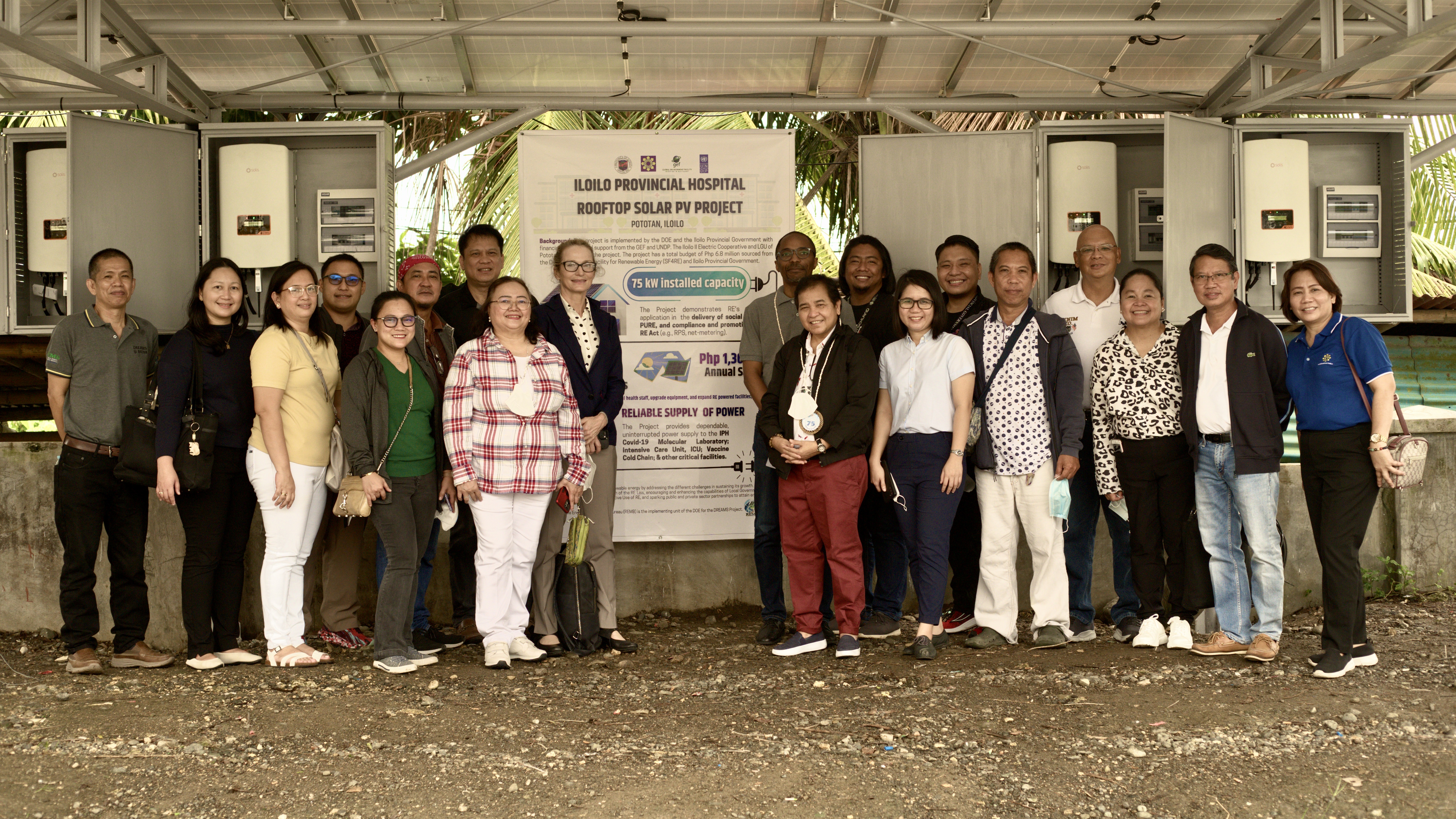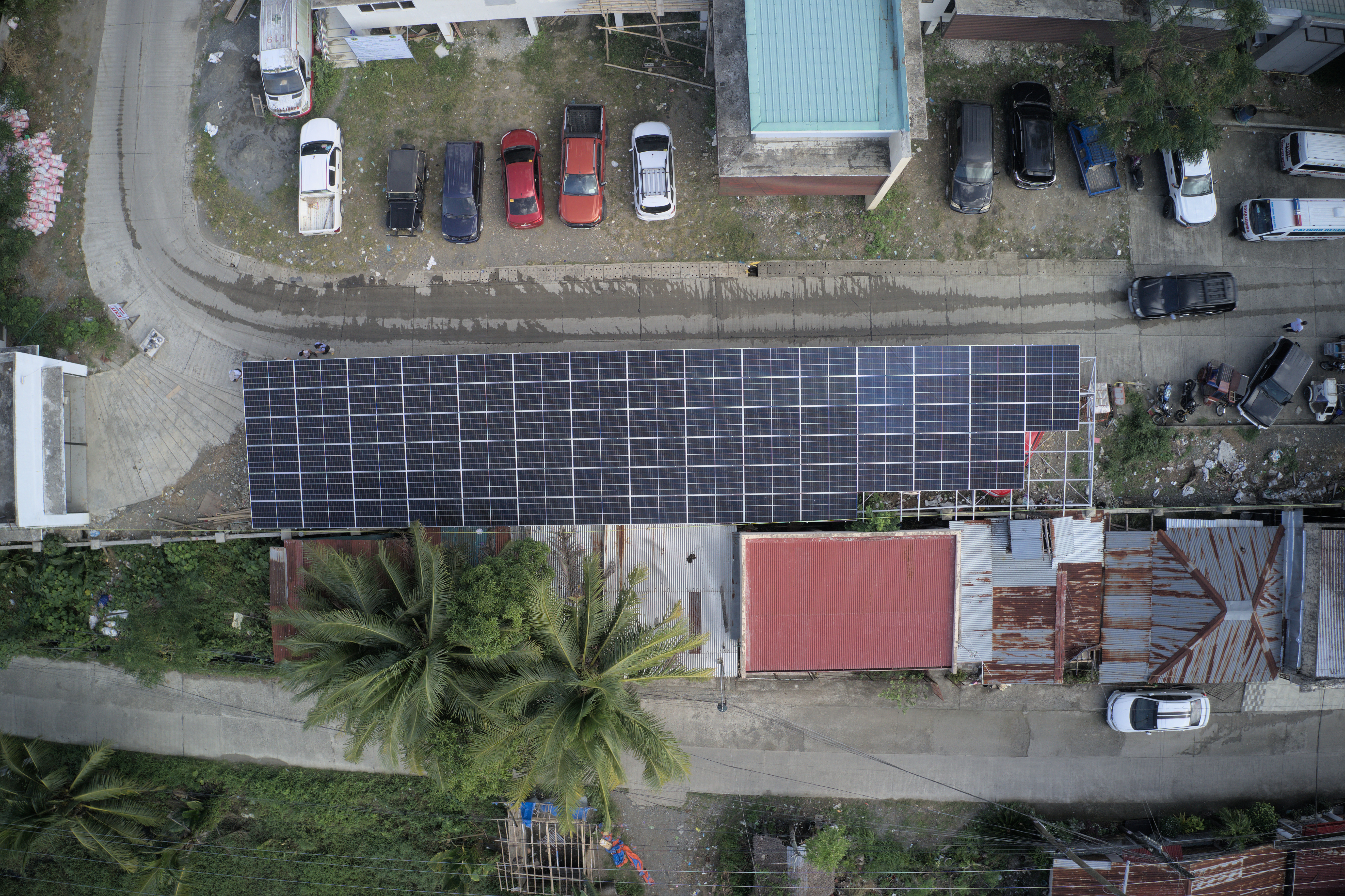Turning dreams into reality: The Iloilo Provincial Hospital solar energization project
March 6, 2023

The solar PV project is made possible through the efforts of UNDP Philippines, Department of Energy, Global Environment Facility, and the Iloilo Provincial Government.
The excitement in the air was palpable – a stark contrast to the gloomy weather and light drizzle that greeted the DREAMS Technical Working Group as they pulled into Iloilo Provincial Hospital’s (IPH) driveway. The scene that they arrived to was reminiscent of a town fiesta. The main lobby was converted into a makeshift stage. Children, teenagers, and their mothers could be seen running around in frenzy carrying pom-poms. A sound system was pumping out the latest pop songs. It was, quite simply, a scene one would not expect to witness in a hospital. As it turned out, it was IPH’s Diamond Foundation Day and the whole community gathered to celebrate this milestone. The overall atmosphere gave the otherwise monotonous technical visit to inspect solar panels a celebratory feel. For Anne Doromal of the Iloilo Provincial Government’s Health Management Office (HMO), the festivities befit the realization of a dream that started seven years ago.
Ms. Doromal, who currently works as the Sanitation Inspector IV at the HMO, shared how a three-woman team from the HMO drafted the initial proposal for the solar energization project. “The project was initiated in 2015 when the Climate Change Commission came here in Iloilo and introduced to us [how to mitigate climate change]. One of these is using renewable energy,” she explained. Along with Ms. Aulynn Yue Sin and Atty. Yoko Marie Eguia, the women put together a proposal to introduce solar power at IPH. This underwent several iterations and was forwarded to different institutions for potential support. Finally, upon learning of the Development for Renewable Energy Applications Mainstreaming and Market Sustainability (DREAMS) Project of the United Nations Development Programme (UNDP) in the Philippines with the Department of Energy (DOE) and the Global Environment Facility (GEF), their proposal was forwarded to UNDP through the Iloilo Provincial Government’s Provincial Planning and Development Office in 2020.
“It started out as a concept for renewable energy for the hospitals of the province of Iloilo,” said Ms. Yue Sin who now heads the Iloilo Local Economic Development and Investment Promotion Center. “The hospitals are operated as economic enterprises, [so] we want to control the manner of spending. One of the things that would really impact the community is to use renewable energy,” she added. The clients of IPH are mostly composed of women, children, and the elderly, underscoring its importance to the Province of Iloilo in making quality healthcare accessible to everyone. “IPH was selected because it is being positioned as a Level 2 hospital,” explained Atty. Eguia, Development Management Officer III at the HMO. Therefore, in terms of the profile of patients and occupancy, IPH is deemed the most ideal location for the renewable energy project. Atty. Eguia also stressed that the economic benefits that will be derived from the project can be used to fund other areas of the hospital’s operations, further improving its service quality. “Any savings that we can generate from the utilization of renewable energy can be diverted to other aspects of the service that are directly related to patient care,” she said. Ms. Yue Sin stated that aside from highlighting the economic benefits of the project, the proposal they drafted also put focus on how it will raise the awareness of the community about the benefits of renewable energy. “That’s where the proposal was anchored on when we conceptualized it. It was a short concept note. It was developed by this team of beautiful ladies here,” she shared with pride.
Established 75 years ago, the Iloilo Provincial Hospital (IPH) is a hundred-bed Level 1 government hospital that caters mostly to indigent patients. It is located in the municipality of Pototan, about an hour away from Iloilo City. IPH is a crucial provider of general hospital services, including medical and surgical care, maternity, newborn and childcare, emergency, ambulance, ancillary and support services, to residents of Iloilo Province and even nearby provinces. In 2018, it inaugurated a brand-new two-storey building that houses an emergency room, medical and surgical wards, intensive care unit, out-patient department, operating complex, OB ward, and teen moms’ clinic, among others. Due to the outbreak of the COVID-19 pandemic, Iloilo Province’s very first molecular laboratory has also been opened within the hospital complex. Because of IPH’s importance in serving as the “hospital for the poor”, there is utmost urgency in ensuring the viability of its operations.

Dr. Madonna Villanueva, Iloilo Provincial Hospital OIC, shared how the renewable energy project can help address the various challenges faced by the hospital.
According to Dr. Madonna Villanueva, IPH Officer In Charge (OIC), the primary challenge being faced by the hospital currently is the reduction of its budget. Dr. Villanueva is an IPH stalwart who started out as an internist at the hospital in 2001. Two decades later, she is now the hospital’s Chief of Clinics and OIC. “I have been here since 2001 so I have seen all the challenges, from the wards to the [operating rooms]. I think the main problem now is the budget,” Dr. Villanueva divulged. One of the hospital’s biggest cost drivers is its electrical consumption. Currently, the hospital’s electric bill comes out at around PHP 400,000 per month. This is expected to increase to around PHP 600,000 per month due to the addition of new hospital facilities. Since IPH is under the auspices of the Iloilo Provincial Government’s Health Management Office (HMO), it is being operated as an economic enterprise which means the hospital needs to be financially self-sufficient. One way to address the increase in the electric bill, and the decrease in budget, is to turn to renewable energy.
The solar energization project enabled the installation of a of 75 kW rooftop solar PV system in IPH. Currently, it powers some of the critical facilities of IPH that need an unhampered supply of electricity. “The project was intended to address the problems with disaster risk reduction for the hospital to have a 24/7 supply of electricity, especially for the molecular laboratory, birthing center, emergency room, and operating theatre,” related Melvin Porzuelo of Green Forum Western Visayas. He was tasked to design the entire project and stressed the solar energization’s benefit of providing energy security to the hospital. “For example, somebody is in labor, and we have a brownout, we need to have emergency lights. And during extreme events like typhoons, we can experience outages for several days or weeks,” he explained. In a region that undergoes rotating brownouts and lies along the path of typhoons that pound the Philippines every year, IPH is in dire need of energy security. Through the solar energization, the hospital’s critical facilities such as its operating and delivery rooms, molecular laboratory and testing center, and intensive care units will have an uninterrupted power supply.
Chief Lourdes Arciaga of the Department of Energy (DOE) Energy Resource Development and Utilization Division Visayas Field Office shared how happy they are to be part of this groundbreaking project. “Our role is mostly on the technical side, particularly in reviewing the design, technical specifications, monitoring and inspection, and ensuring the sustainability of the project,” she explained. “One of the main services of the hospital is for maternity, and also for childcare. So, major beneficiaries of this project are really the mothers, the pregnant women, and the children,” Chief Arciaga expounded.

Dr. Madonna Villanueva, Iloilo Provincial Hospital OIC, shared how the renewable energy project can help address the various challenges faced by the hospital.The 75 kW rooftop solar PV system is expected to reduce the hospital’s electric bill by 30% and deliver uninterrupted power supply to its vital facilities.
The DREAMS renewable energy project at IPH indeed was able to hit several birds with one stone. In terms of economic benefits, the solar PV system is expected to reduce the hospital’s electric bills by 30%, translating to savings of PHP 138,000 per month. “The cost that would be deducted from the electricity can be allocated to other needs of the hospital like for drugs and medication, medical equipment, and repair,” Dr. Villanueva remarked. The environmental benefits were also highlighted in the face of the compounding effects of climate change. The project will contribute to climate mitigation efforts with its emission avoidance of approximately 90 metric tons of carbon dioxide equivalent annually. “This is a very good project because when you say solar energy, it is a clean and renewable source of energy. So, it is really important in dealing with climate change nowadays,” she noted. Lastly, she also hailed the uninterrupted power supply as a major boon to the operations of IPH. “One advantage is that it will give us an uninterrupted supply of electricity, especially in vital areas like the [emergency room], operating room, delivery room, molecular [laboratory]. Even if there’s a blackout, the power will be stable, so the surgeons will not have a hard time,” she explained. Dr. Villanueva conveyed the hospital’s utmost appreciation for the project as it will greatly help the IPH to continue providing quality health services to the community. With the project’s expected lifespan of 25 years, the solar PV panel system is seen to power IPH until its 100th year. “Maybe it can reach a century! Who knows, our children might benefit from it later,” Dr. Villanueva expressed hopefully.

 Locations
Locations



